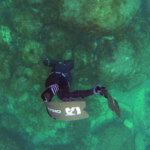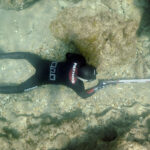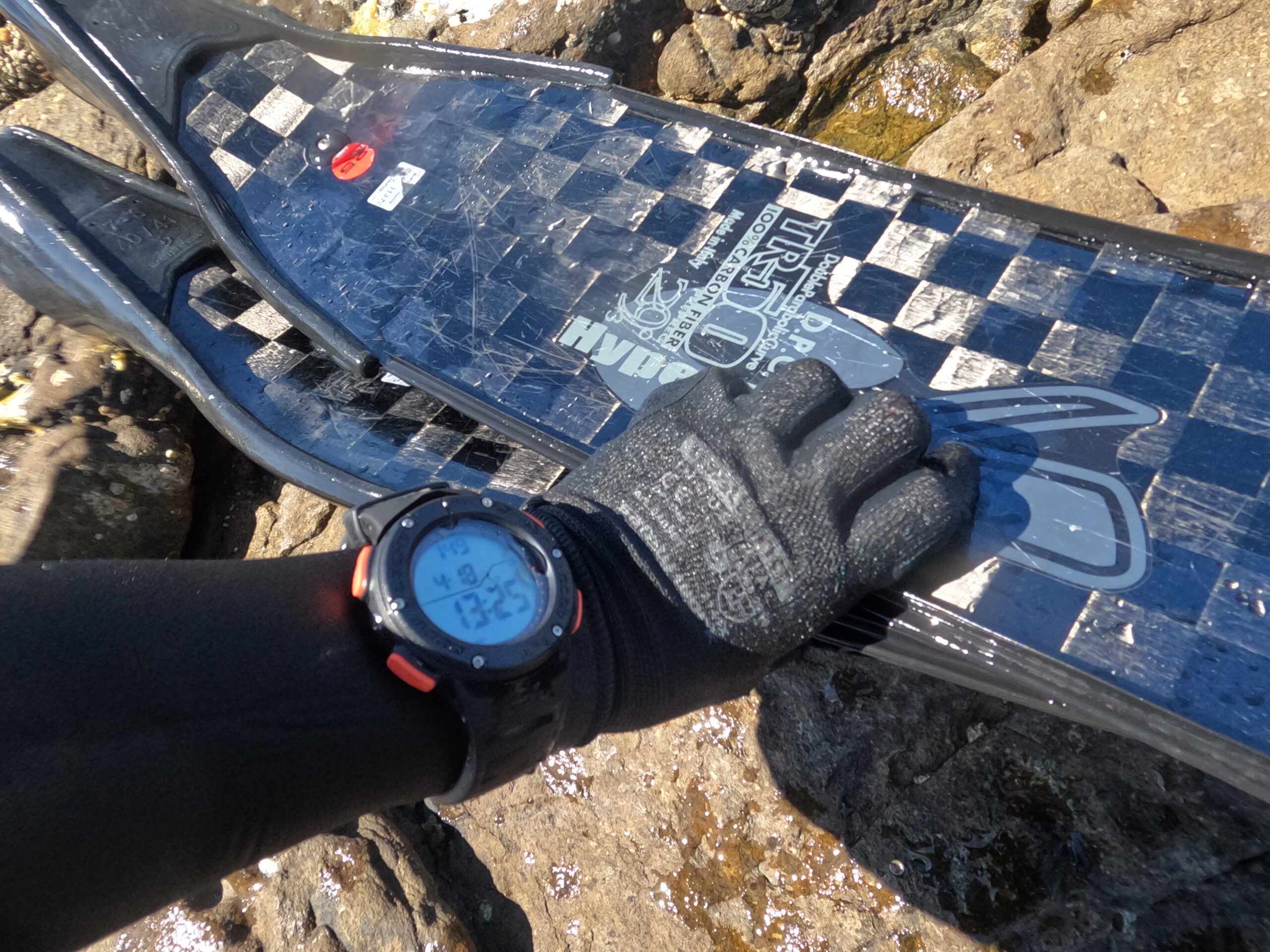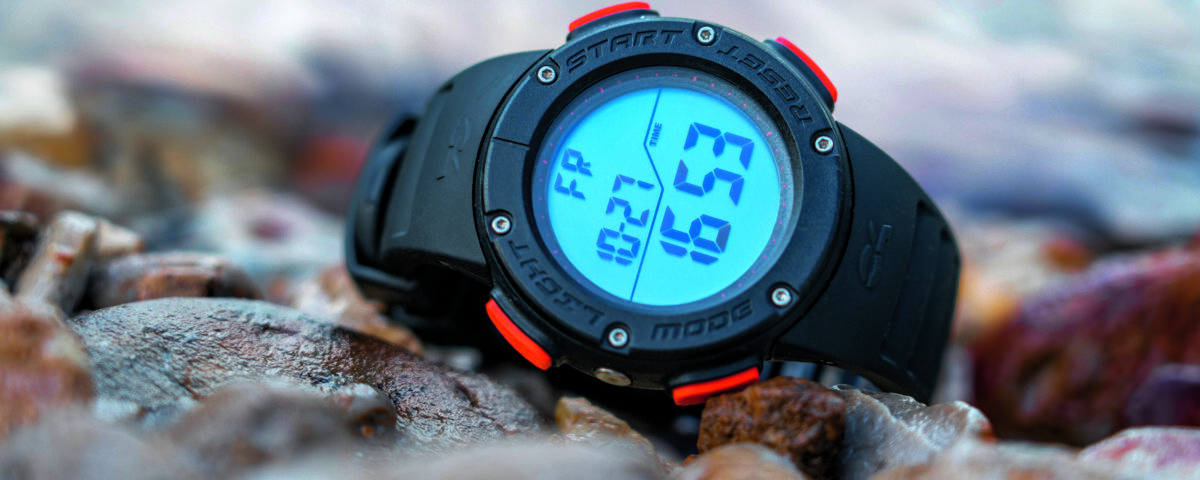H.DESSAULT: Computer Stark

CRESSI: Gara Modular Boost
19 June 2024
PATHOS: Ultra Wetsuit Review
19 June 2024The new computer has all the useful functions for spearfishing and freediving, with an easy-to-use menu and large numbers on the screen! Moreover, it boasts an "immortal" battery and unparalleled material robustness
Cristian Righetti
As soon as I received it, I was pleased to note that the packaging is cardboard, thus “eco-friendly”: it consists of a thinner cardboard cube open on two sides with the characteristic H. Dessault logo, the name Stark, and an outline of the computer’s shape engraved in cursive, all with an elegant interplay of black and silver; and a proper box (which fits into the cube, housing the instrument, “cuddled” in a bed of pre-formed foam).
The instruction manual, translated into 4 languages (English, Italian, French, and Spanish), is also available on Dessault.com.
Once the “treasure chest” is opened, here is finally the gem in my hands. The first thing that catches the eye is the size of the numbers on the screen, which I naturally associate with incredible ease of reading during fishing action or freediving sessions!
Analyzing it dry, the Stark appears as an instrument with a modern and elegant, yet sporty, design, almost entirely made of thermoplastic material: the case is made of black reinforced shockproof material, while the strap is also black.
The case features a rough thermoplastic bezel, where the corresponding menu functions (light, start, mode, and reset) are engraved, and it is secured to the main body by six hexagonal stainless steel micro-screws. Additionally, the case has four colored buttons set externally in a beautiful coral red. The whole thing measures 56 millimeters in diameter.
The strap shows a sporty design with horizontal slits on both ends. It has two functional loops to keep the end in place and prevent it from moving annoyingly during movement. Furthermore, both loops have a rectangular hole where a locking “tooth” fits, providing extra security that it won’t come loose. Speaking of numbers, the strap is 4 millimeters thick, and the total circumference, resulting from the sum of the strap + the case, is 31 centimeters; a length that allows you to wear the computer on your wrist even with rather thick wetsuits without the strap squeezing your wrist too tightly.
The screen is monochromatic, measures 30 millimeters in diameter, and is backlit; the glass is made of tempered mineral. The only stainless steel parts are the base of the case (attached to the main body by four torx micro-screws, where the maximum depth of 100 meters and the serial numbers are imprinted), the strap buckle, and all the micro-hardware. Limiting the use of steel gives the computer a weight of only 100 grams, without compromising robustness and resistance, nor the size of the dial, which are strengths of the Stark.
The instrument uses a non-rechargeable battery. H. Dessault has declared an autonomy of more than 2500 hours in dive mode. Truly surprising! It is easily replaceable by unscrewing the four screws on the steel cover under the case. However, the warranty will only be valid with battery replacement at authorized centers.
It's time to get familiar with it, so I start “playing” with the Stark to check out the various functions; there are three main ones, those of interest to the fisherman and freediver: Clock, stopwatch, and diving.
It takes only a few minutes to learn and master these options; it is really easy to use and essential. It should be noted that the instrument automatically starts in Dive mode only after selecting the Dive function; once you enter this “page,” it will automatically activate only after exceeding a depth of one and a half meters.
The recording of performed dives is up to a maximum of 200; for these dives, the total time, maximum depth, minimum water temperature, start time, and date are recorded. Once you reach 200 dives in the logbook, the computer will store the last dive as the 200th and automatically delete the oldest one recorded in memory.
I make sure to set it with the units of measurement I am comfortable with: in the settings display (obtained by pressing the Mode button for at least two seconds), press the Mode button to go beyond the current time settings until "C" or "F" for temperature flashes, the same for "M" meters (as opposed to ft/feet) for depth and "Sea" (sea) mode compared to "Lake" (lake) mode for the water density sensor, as I will use it in saltwater.
Another interesting safety feature is the audible alarm, which can be set to a certain depth. In stopwatch mode, finally, the Stark measures elapsed time and current split time. The stopwatch has a measurement resolution of 1/100 second and a duration of 100 hours.
At Sea
Beautiful day in April, calm sea but affected by freshwater currents present around the spot, so not particularly clear on the surface. I wear a 7mm wetsuit and to avoid leaks I tuck a 3mm glove inside the cuff, but despite this thickness, I wear the Stark without any discomfort. In fact, I have plenty of room to adjust it perfectly. And so I do.
Before starting the fishing session, you should always remember to set the instrument to the dive/logbook page by selecting it with the Mode button; at this point, the dive function will start automatically as soon as a depth of 1.5 meters is exceeded. This is certainly a small disadvantage of the Stark as it is possible to forget to perform this operation. It would be more convenient in my opinion if it started automatically, but in all fairness, I can say that once you are aware of this, and with frequent use of the instrument, this action will become almost instinctive.
As soon as I put my head under the water's surface, I immediately notice the characteristic blur effect created by the freshwater; at first glance an annoying situation, but perfect for testing the Stark and the visibility of the numbers on the screen. Thanks to the size of the figures and the dive information, readability is far superior to other models on the market. Definitely a significant strong point.
The day seems stingy with catches and I think to myself that these freshwater streams bother the fish when a cloud of small seabream starts the classic carousel and approaches. I look for something “serious” in the school, but nothing. I glance at the Stark, it indicates a depth of 3.6 meters and a "dive time" of about a minute, the temperature is 16 degrees. Just as I lift my gaze from the whitish water, I spot a snout pointing at me, but I can't immediately associate it with a particular species due to the muffled visibility. At least until it comes a few meters closer and I realize it’s a nice dentex. It's facing me, it quickly turns and I hit it on the fly; it struggles a lot, but luckily I manage to grab it before it tears away, given the low shot. What a satisfaction! A beautiful fish, almost 3 kilos, in such shallow water!
Once on the surface, the little computer automatically switches to Surface mode, indicating the minimum water temperature recorded during the dive, the dive time, and the surface recovery time, which is essential for us fishermen.
I continue heading further offshore in search of clearer water. I perform glides at 10 meters and with each descent or ascent, the Stark indicates the dive phase with an arrow pointing downwards and the ascent phase with an arrow pointing upwards. I’ve been in the water for a while and want to see what time it is: I have two options, by pressing the Mode button for 2 seconds or after 30 seconds without contact with the water, the clock switches to Current Time mode.
Then pressing the Mode button again, the Stark switches to logbook/dive mode indicating for each dive the minimum water temperature, dive time, and maximum depth. At this point, on a subsequent descent, to a depth of at least 1.5 meters, the depth gauge will switch back to Dive mode.
I decide to end the fishing and the stress test of the Stark here. I come out convinced that I have tested a computer that can be worn excellently with any thickness of wetsuit and, above all, resistant, very intuitive, and easy to manage, essential characteristics at sea, and which shows all the information literally in “block letters.” For the joy even of fishermen with eyesight not exactly like an eagle’s!
Ratings
Ergonomics: 9 the Stark is resistant, lightweight, and equipped with an ergonomic strap. The 4 buttons are easy to press and the dial readability is superb!
Build Quality: 7 certainly good. The case is made of shockproof thermoplastic material, the strap is made of resistant thermoplastic material, the bottom case cover is stainless steel, and the dial is made of tempered mineral glass.
Ease of Use; 9 it is almost instinctive to use, and you immediately develop a good feeling with it. Just spend about ten minutes to delve into and set up the various functions.
Functions: 7 it has everything needed for spearfishing and freediving. You can quickly switch from one function to another with the Mode button. It’s a pity it doesn’t automatically switch to Dive mode from the Current Time function.
Autonomy: 9.5 it consumes very little and the battery life is exceptional. The company claims 2500 hours in Dive mode.
Value for Money: 8 it lists for €219. I’d say it's excellent.



